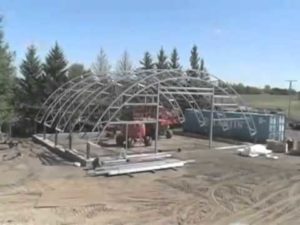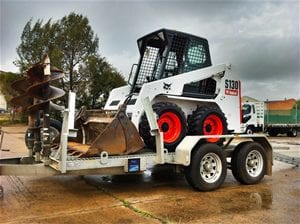Creating product demonstration videos will not deliver an immediate increase in sales or inquiries from potential buyers. It is possible to create a product demo video that depresses sales. And scares potential buyers away. Here are the top mistakes that I see manufacturers making with their product videos.
Mistake #1: All Visuals, No Words

Can you tell from this product demonstration video that this riding lawn mower deck shell features dual steel sheet construction (1/4” thick combined) for increased strength and spindle support? Neither can potential buyers. Your demo video needs to tell, then show.
A picture is never worth a thousand words. And neither is a video. A video that demonstrates a product in use rarely communicates everything the manufacturer wants to communicate with visuals only. Words are needed, either in the form of narration (sound) or subtitles (visuals), to describe or explain what the viewer is seeing.
Let me give you an example
Imagine that you manufacture riding lawn mowers for commercial applications. You figure that having a video of your product in action is a good idea, which it is. So you head out one sunny afternoon and shoot lots of footage of a lawn care contractor mowing a yard. You show the mower going up and down the yard. You show the operator doing turns. You show the deck mowing up close to hedges. All good. Then you post your video online and wait for the orders to pour in.
The challenge that you face is that your viewers rarely understand what they are watching. They do not know the unique features of your product, or the unique benefits, simply from watching your video. These things need to be explained, either with a voiceover track (a narrator) or subtitles.
Visuals are never enough
For example, just watching a demo of your riding lawn mower does not tell a potential buyer that your mower has a unique hydraulic wheel-drive system that lets the mower rotate on its own axis with a zero turning radius. That feature and that benefit need to be stated explicitly.
Neither does the video explain how the deck lifting system works. Your video may show the operator depressing the foot pedal, and then show the deck raising to adjust the cutting height, but your viewers will not understand that this operation is also done hands-free (unlike competing products). That needs to be explained. Simply showing the feature in silence is rarely enough. A voice needs to add an explanation, or a subtitle needs to describe what the viewer is seeing.
They have to know before you show
The key thing to remember about product demonstration video footage is that it is designed to illustrate rather than state. The visuals in the video are meant to show something that the prospective buyer has just been told. The feature is first stated, then it is illustrated. The product benefit is first explained, then it is shown.
You must remember that your potential buyers have differing levels of familiarity with your product and your product category. In keeping with our example, above, some buyers of commercial riding lawn mowers don’t know what a zero radius turn is and don’t appreciate why this feature is a benefit. They are rookies. If they see that feature being demonstrated in a video, with no sound and no subtitles, they may not appreciate what they are seeing.
Other buyers are more sophisticated, and understand the features and benefits of commercial riding lawn mowers well. But every product is unique. And these potential buyers need to be told in explicit terms why your riding lawn mower is better than competing models, and then they need to see that difference being demonstrated in a video.
Show and tell, sort of
As you can appreciate by now, the secret to avoiding this mistake is to always explain or describe what viewers are seeing on screen. Never take for granted that your viewers understand what they are watching. A video is never worth a thousand words. It always needs some words, either narration or subtitles, to help prospective buyers understand what they are watching.
If you want your product demonstration video to be successful, first make your claim, then illustrate that claim. It’s like show and tell, except the other way around. First tell, then show. You’ll notice the difference in no time. In increased inquiries. And sales.
Mistake #2: A Video with No Story
The second mistake that we see in product videos produced by manufactures is absence of a story, absence of a logical, progressive sales argument.
Video is a story-telling medium. If you want to present a bunch of statistics or facts or figures, publish a specifications sheet or technical document. But if you want to engage your potential buyers, if you want to grab their attention and pique their interest and keep their attention, then you need to tell a story in your product demonstration video.
I’m not talking about a story that begins, “It was a dark and stormy night . . .” I’m talking about a story that has a beginning, a middle and an end. A story that speaks directly to your audience. A story that addresses their concerns, their needs.
How not to produce a product demo video

Think sheep are boring to watch? Try watching their home being built in a time-lapse product demonstration video.
Let me give you an example of a product demo video that gets it wrong. A manufacturer of fabric covered buildings creates a time-lapse video of his crew erecting one of its buildings. The video lasts six minutes and, like all time-lapse videos, shows the speeded-up action that you’d expect when a crew uses scissor lifts, ladders, power tools and other equipment to erect a fabric-covered building.
If you’re like any typical buyer, you find it hard to sit still through a six-minute time-lapse video. That’s because the essence of what you’re watching can be communicated visually in 60 seconds. But this manufacturer expects you to witness every single stage of the building being put up, and I mean every single step, because that’s what a time-lapse video captures.
The mistake here is that the video has no story. It has a logical flow, of course. It starts with bare foundation walls and ends with a covered structure, but other than that it lacks any coherent sales message, any logical argument for buying this brand of building. It has no story that is likely to engage the imagination of a buyer.
Now consider the power of story
Now imagine another manufacturer of fabric-covered buildings. This manufacturer opens his video with a shot of a burned-out barn and hundreds of sheep running about a farmer’s property. The narrator tells you that Bill Weber lost his sheep barn one cold January to an electrical fire. He was in dire need of a new structure, and so were his sheep.
The video then shows Bill talking with a builder of wood barns. Then a manufacturer of fabric covered barns. The narrator describes why bill chose the fabric-covered structure.
Cut to a scene of Bill and his wife standing in their yard one early morning as the sun rises. An installation crew from the manufacturer pulls into their driveway. The driver smiles and waves hullo. Cut to a shot of the manufacturer’s logo on the truck door. Shots of the workers leaving the truck and getting ready on the job site.
Now a close-up of a worker picking up the first structural member and setting it into place as he chats with Bill the farmer, who is standing by.
Then a series of quick shots of the crew installing the various components of the building as the narrator explains what they are doing, why they are doing it in that order, the benefits of the manufacturer’s building, the ease of construction, the speed of the assembly, the convenience for the farmer, and so on.
Cut to a shot of the sheep standing about in the yard, shivering, watching the construction.
Cut to a shot of Bill telling an interviewer why he chose this manufacturer and this building, and how satisfied he is with his decision.
Then a shot of a crew member placing a sign at the end of the building, Weber Farms. Cut to a reaction shot of Bill and his wife on the ground, looking up at their family farm sign being set in place.
Next, a shot of the crew foreman shaking Bill’s hand as a worker in the background guides the sheep into their new home. Then a shot of the sheep settling down for a night’s sleep. Then a shot of the workers cleaning up the site and climbing into their vehicle. Close on a shot of the manufacturer’s vehicle driving out the lane into the sunset as Bill and his wife stand in their yard, arm in arm, looking at their new barn. The End.
Give yourself the credit
You may have a product that cannot be demonstrated with a story of this find (a family-owned business, a calamity, your client featured in your video, for example). But you do have a story to tell. Every manufacturer does. Every product does. With a bit of imagination and a dose of creativity, any product can be dramatized. Any product can be described in the form of a story.
When you go to the trouble of telling a story, things turn out alright in the end. Your potential buyers reward you with their attention. And their business.
Mistake #3: All Features, No Benefits
Someone once observed that a carpenter doesn’t buy a quarter-inch drill bit because he wants a quarter-inch drill bit. The carpenter buys the quarter-inch drill bit because the carpenter needs a quarter-inch hole. The carpenter needs what the drill bit supplies. The size of the bit is the feature. What the bit produces is the benefit.
The same rule applies for consumer electronics that have wi-fi functionality. A consumer doesn’t buy a smartphone because it has wi-fi operating on the 2.4 gigahertz radio band. The consumer chooses the wi-fi-enabled phone because wi-fi gives the consumer free, wireless access to the internet. Wi-fi is the feature. 2.4 gigahertz is the feature. Free, wireless access to the internet is the benefit.
All of this is to say that customers buy benefits, not features. And yet one of the most common mistakes that manufacturers make in their product demonstration videos is concentrating on features and forgetting about benefits.
A demo video that’ all about features, flops

Which do you care about more? That this trailer is built with 7-gauge steel? Or that it helps you do your job faster?
Here’s what I mean. Imagine you’re a landscape contractor in the market for a trailer that you can pull behind your pickup truck. You need a trailer strong enough to carry a BobCat or other brand of skidsteer.
So, you visit a manufacturer’s website and watch a demonstration video of their trailer. The video shows the trailer from various angles, shows a BobCat being driven onto and backed off the trailer, and in other ways demonstrates the utility of the trailer.
All good so far.
But what does the announcer on the video tell you about this model of trailer? Here goes . . .
“The Cattitude Trailer from BobCajune Manufacturing features a powder coat finish. The trailer bed is made from 7-gauge steel. The bed raises to an angle of 51 degrees. Comes with a storage tray behind the coupler.”
Now if you know a great deal about the kinds of trailers that landscape contractors need, you understand these features, maybe. But because the manufacturer has not explained them, and because the manufacturer has not told you the benefits associated with each of these features, you are not further ahead in your buying decision.
A good product demo video describes features and benefits
A successful product demonstration video not only demonstrates a product’s features, it also describes the benefits of those features. If we were shooting and producing this video, we might very well shoot the same types of shots that the original videographer shot, except that we would draw attention to the benefits. We would spell them out, because customers buy benefits, not features.
For example, we’d show some clips of the powder coat finish being baked on at 400 degrees Fahrenheit, and tell you that this finish never chips. So your trailer always looks terrific. Maintaining your brand is a benefit.
Then we’d show a few clips of the trailer bed being manufactured from 7-gauge steel. We’d tell you that 7-gauge steel is 3/16 inches thick, much thicker than competing trailers (which are only 10-gauge), and that this thickness means you can drive a skidsteer with steel tracks onto this bed without damaging it. Longevity is a benefit.
Then we’d show the trailer filled with landscaper’s mulch. We’d show a closeup of the operator holding the remote control, and raising the bed. We’d tell you that the bed raises to an angle of 51 degrees, the steepest in the industry, which lets you dump 7 cubic yards of wet mulch in under 30 seconds. Speed is a benefit.
Finally, we’d show a worker throwing tools into the built-in storage tray behind the coupler, and explain that it holds your wheel blocks, chains and ratchet straps for easy and quick access. Convenience and speed are benefits.
There are benefits to showing benefits
You can literally see the difference between these two approaches. One shows you the only features, the other shows you the features and the benefits of those features. Remember, customers, whether they are individuals or businesses, buy benefits. So, if you are a manufacturer, make sure your product videos demonstrate both features and benefits. The benefit to you of doing so is more customers, more sales.
Mistake #4: Poor Audio
Want to know the easiest way to alienate a potential customer who is watching your product demonstration video? Make sure the audio track in the video is lousy.
Buyers will tolerate all sorts of shaky camera footage and cheesy transitions and nerdy titles, but few will tolerate bad sound.
Bad audio is the mark of an amateur production. Just think about the Hollywood movies you watch. Some of them have frenetic camera work, where the camera operator is either holding the camera and running about, or the movie jumps from one scene to another at a rapid pace. But all Hollywood movies have good audio. That’s because audiences will sit through unconventional camera moves, but they won’t sit still if the sound is impossible to listen to.
Here are the common audio problems that we see in videos produced by manufacturers:
- MICROPHONE TOO FAR AWAY: The number-one rule of recording good audio on set or on location is to get the microphone as close to the speaker as possible. When the microphone is too far away from the person speaking, the sound level will be too low, and difficult to hear. It will also be difficult to remedy in post-production (in the studio after the scene is shot).
- CAMERA MIC USED: Some manufacturers try to save money by shooting their own product demo videos using a digital SLR, sometimes even an iPhone. The built-in microphones on these cameras are notoriously poor at recording voices that are more than a few feet away. The solution is to use an external microphone, plugged into the audio in socket on the camera or phone.
- AMBIENT NOISE: Ever tried to hold a conversation on the shop floor of a manufacturing plant while the equipment is up and running? Not easy. Manufacturing facilities are noisy, and the noises are often unpredictable. A microphone, regardless of its quality, picks up the sound of hammering, grinding, welding, sanding and the beep-beep-beep of forklift trucks reversing. The same goes for noises outside. Wind passing across the mic is particularly annoying. And a dog barking at random in the distance for recreation is a distraction. The solution is to use a directional microphone that picks up only the sounds immediately in front of the mic, or, if you are interviewing someone, to interview them in a quieter location and then shoot footage of them in the factory, in the spots where you were going to record them.
- BACKGROUND MUSIC TOO LOUD: Music can add a great deal to your video. The right track can add an emotional element that cannot be achieved in any other way. But if your video features a person talking while the music plays in the background (or while the music plays “under” the speaker, as we say in the trade), then you must get your levels right. If the music is too low, it may as well not be playing at all. And if it is too high, it drowns out your speaker and frustrates the folks watching your video. Balancing voice tracks and music tracks is an art. Get it right and your viewers will reward you by watching—and listening to—your video.
- MIC TOO CLOSE TO CLOTHING: A lavalier mic is a microphone that clips onto a lapel or shirt collar. It is great at picking up the voice of the person wearing the mic, but it also picks up the noise of fabric that passes across the mic. When you place the mic onto the person you are interviewing, make sure it is not rubbing against their clothing. And prompt your speaker to keeps hands and arms away from the mic. People who speak with their arms sometimes brush against the mic, which makes a scratching sound on the recording.
Mistake #5: Camera Mistakes
Content isn’t the most important thing in your product demonstration video. You have watched PowerPoint presentations and educational videos that contained vital information, yet were deadly dull visually. Content isn’t enough, anymore than ingredients without a recipe or a chef are enough.
Your goal in producing your demo video is to present a vital marketing message in a visually interesting way. Avoid the mistake of thinking that your marketing message, presented in a logical, persuasive way, is enough to sway a potential customer. It’s not.
The video that demonstrates your product needs to be visually interesting. In other words, it needs to be interesting to watch. Here are a few of the common mistakes to avoid.
- STATIC SHOTS: A tripod is one of the most important pieces of equipment on a video shoot. It keeps your camera steady. Steady camera work is the sign of a professional. Shaky camera work is the sign of an amateur. But you need to mix things up. If all of your shots are static, if you have no camera movement, ever, your video will be less interesting visually. Add variety to your shots with pans, pan reveals, tilts, slider moves, dolly shots and other creative camera movement.
- FEW ANGLES: Another common error is shooting everything from eye level. Interviews at eye level. Product shots at eye level. Exterior shots of the manufacturing plant at eye level. Boring. Add visually variety by adding a variety of camera angles. Shoot from the floor, looking up. Shoot from a gangway, looking down. Shoot over the shoulder of one person in a conversation. Shoot from waist height. Mix it up.
- ONE SHOT SIZE: The world you live in has depth. Some things are close. Some things are in the middle distance. And other things are on the horizon, or farther away. Your product demonstration video, to keep your audience’s attention, needs to present your product with a variety of shot sizes. The shot of your building exterior, for example, will likely be a wide shot. The shot of your president talking on camera can be a medium shot (from the waist up). And your shots of your product should include medium and close-up shots, where a part of the product fills the screen. Get this variety by changing the focal length of your lens (zooming in and zooming out), and by walking away from and up to your subject.
- NO MOVEMENT: Charlie Chaplin’s early movies were black and white and had no audible dialogue, yet they were entertaining to watch because they had movement. The quickest way to add interest or drama to your product demo videos is to add movement. Instead of opening a shot with your engineer standing next to your product, open on the product and have your engineer walk into the frame and up to the product. If your product has wheels, show it in motion. If your office has doors, show people walking through them. If your product can be picked up, pick it up. Turn it. Angle it. Hand it to someone. Put it in a shipping box. Add movement, add interest.
- TOO FAR AWAY: Most people, when composing a photograph, stand too far away from their subject. Which makes the subject small and difficult to see. The rule of thumb in videography is to get close. Get as close to your product as possible without breaking any of the other rules of videography (balance, proportion and the rule of thirds, for example). If you are shooting people, get some shots of them from the waist up. If you are shooting a large product, such as a combine harvester, get lots of shots of the machine from a multitude of angles. Don’t think you have to include the entire machine (front to back, top to bottom) in every shot. Because you don’t.
- VISUAL DISTRACTIONS: One of the beauties of video is that it helps you control what your prospective customer looks at. When you want to draw their attention to a feature of your product, you zoom in on that feature. When you want to show how your product is used, you show someone using it. When you control what your viewer looks at, you control what they take in and understand about your product. For this reason, you must avoid everything that will distract your viewer. Visual distractions to avoid include:
- People walking into and out of your frame during filming
- Busy backgrounds, filled with colors or objects or people, that are more interesting to look at than your subject
- Shaky camera work
- Too much camera movement



Recent Comments